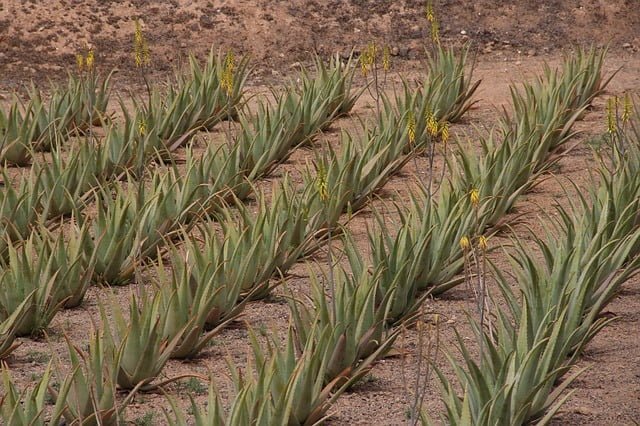This ultimate guide on Aloe Vera farming will guide you in cultivating Aloe Vera in your farm. Learn about Climate, Soil, Fertilizers, Irrigation, etc. requirements to get higher yield and benefits.
Leaves of Aloe Vera have lot of medicinal uses, that’s why we call Aloe Vera a medicinal crop. Leaf pulp is used to treat liver disorder, rheumatism, skin disorders, and intestinal worms. That’s why demand for Aloe in the global market is high.
Table of Contents
Introduction
Aloe is small, stemless, herbaceous, succulent perennial plant with shallow root system from aloeaceae family. They flower from October to January and produces fruit between February to April.
Few important species of Aloes are Aloe perryi, and Aloe succotriana. If you cultivate this crop in your farm then you can take 3 to 4 pickings per year.
Farmers can start harvesting from second to fifth year after plantation. This means you will be saving lot of investments in field preparations along with consistent income every year.
Aloe Vera global market is expected to reach 915 Million US $ by 2025. If you are planning to cultivate medicinal crop then Aloe can be a good choice. After harvesting you can sell them to local markets or can sign a contract with companies.
Origin
Researchers believe that Aloe originated in the Arabian peninsula. They are native to Southern Africa, Jordan, Madagascar, and various islands in the Indian Ocean.
Aloe Vera Farming Guide

Climate
You can cultivate Aloe Vera in wide range of climatic condition. Warm, humid or dry climatic conditions are good for Aloe farming. However, high humidity can cause diseases. For germination of seeds ideal temperature range is 24o Celsius.
Annual rainfall between 1000 to 1200 mm is considered excellent for cultivation of Aloe.
Soil
Although Aloe Vera can grow on variety of soils but well drained sandy, sandy coastal to loamy soils with 8.5 pH are ideal. Avoid cultivating this medicinal crop in clayey or waterlogged soil as it can cause serious damage to the crop.
Field Preparation
Root system of Aloe Vera do not penetrate below 20 centimetres, therefore there is no need for deep ploughing. Before cultivation, plough the field twice and clear all the weeds. You can also prepare drainage canals to remove excess water from the farm.
Propagation
Although you can grow Aloe Vera from seeds but for commercial production practice vegetative propagation methods. You can propagate Aloe through root suckers or rhizome cuttings. The best planting time for root suckers is at the end of rainy season.
You can either purchase seedlings from local markets or can raise them in shaded nursery. To prepare nursery beds use large quantity of sand and little organic manure. Plant rhizome cuttings or suckers closely having at least 2 nodes in beds.
After few weeks germination will start. Transfer these germinated cuttings and plant them at 30 centimetres distance. Once they reach 3 to 4 leaves stage, then you can plant them in the farm.
Planting Time & Distance
You can plant Aloe Vera throughout the year. But according to growth habit beginning and end of rainy season is the best time to plant Aloe. You can plant seedlings at a spacing of 60 × 30 centimetres or 60 × 45 centimetres.
In this way you will be able to plant 20 to 25 thousands seedlings in one hectare of land. Plant 15 to 18 centimetres long root suckers or rhizome cuttings and keep two thirds of their portion under the ground for best results.
Planting Method
Few months before planting, prepare pits of 30×30×30 centimetres size. Leave these pits exposed under direct sunlight for few weeks. After that fill these pits with a mixture of top soil, organic manure, and neem cake. At the time of plantation dig a small hole and plant seedlings by firmly pressing around the base of the plant.
Fertilizers
You do not need to apply heavy amount of fertilizers. Apply any bulky organic manure @10 to 15 tonnes per hectare before first ploughing. After the plant gets established in the farm you should also apply 150 Kilograms per hectare Nitrogen, Potassium, and Phosphorus.
Irrigation
Irrigate the field soon after plantation of Aloe. Irrigate according to the moisture content of the soil. 4 to 5 irrigations per year are sufficient for Aloe. Avoid waterlogging condition in the farm to prevent plant from fungal diseases.
Plant Protection Measures
Periodically Weeding and pruning is required to maintain good growth. Generally this crop is not affected by any serious pests. But disease like leaf spot can damage the crop. In case of infestation spray Mancozeb or Bordeaux mixture to control this disease.
Harvesting
You can harvest Aloe Vera crop 8 to 12 months after plantation. For harvesting cut leaves at the base with sharp knife and avoid damage of stem. You can also harvest with the help of tractor drawn disc harrow or cultivator.
Yield
You will start getting commercial yield from 2nd to 5th year after plantation of crop. On an average you will get yield of 15 to 20 tonnes per hectare.
FAQ
Is Aloe Vera Farming Profitable?
Yes indeed cultivation of Aloe Vera is profitable. According to an estimate you can earn up to 2,00,000 Indian Rupees from an acre of Aloe farm.
Is possible Aloe Vera cultivation in shadow area?
Aloe Vera plants can thrive well under partial shade sunlight, hence you can cultivate them in shadow area. But avoid cultivation in completely dark areas.
I want to do Aloe Vera farming How can I get my production sold?
You can start contact farming of Aloe with companies like Patanjali to sell your production.





Good day
My name is Thapelo Letseku in South Africa.I am very interested in farming aloe vera.I already have a small farm for aloe vera.i would like to learn more about aloe vera and the marketing of it
Thank you
Thapelo Letseku
Hi,
All the best, I hope this article will be useful for you in practicing Aloe Vera farming. For selling and marketing I will advice to connect with local industries associated with production of products made from Aloe such as face wash, gel, etc.
Thanks for connecting with Agriculture Review!
It is very useful and I am very interested to cultivate this PLANT
All the best!
I am interested in farming of Aloe vera.
Welcome, I hope you will find this article useful.